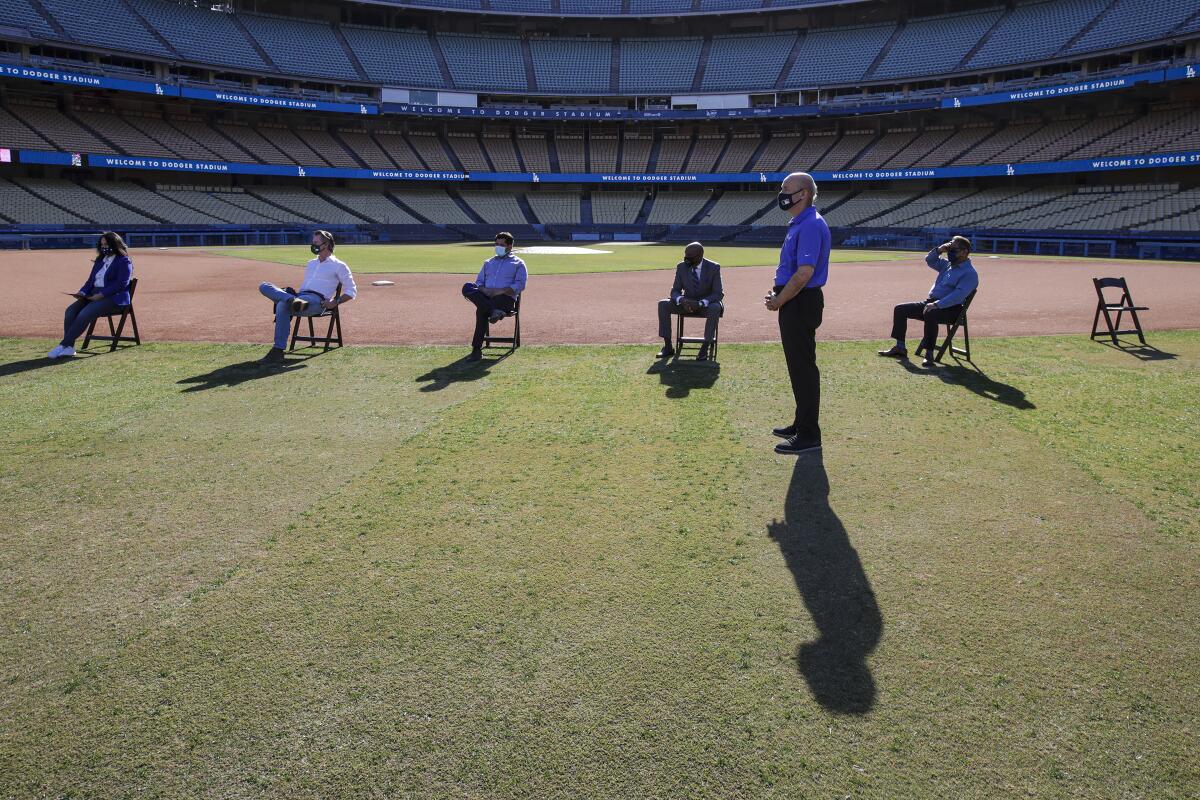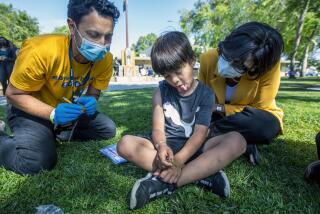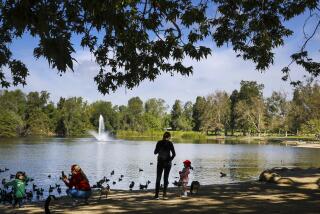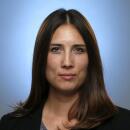Dodger Stadium takes center stage in L.A.’s COVID-19 vaccination campaign

- Share via
The cars line up next to where syringes are filled on small rolling carts. One by one, workers wearing face shields bend down to talk to the drivers through their open car windows about the vaccine they’ll be given. The patients are jabbed with the shot while still buckled in and 15 minutes later, most are cleared to leave and drive off.
The scene on opening day of the mass COVID-19 vaccination site at Dodger Stadium resembled a pop-up, open-air factory, with workers carrying clipboards amid white tents and a sea of orange cones. With an initial goal of vaccinating 2,000 people on the first day, officials expanded the goal to 3,000 because the operation was running smoothly as workers practiced ramping up to the ultimate goal of vaccinating 12,000 people per day.
“This site will move us closer to a day we can’t wait to wake up and hear about. A day when we record zero deaths here in Los Angeles,” said Los Angeles Mayor Eric Garcetti, standing on the field as he announced the new site in the parking lot just outside.
Garcetti said the city will soon be able to vaccinate 20,000 people per day with the help of additional sites, including fire stations. He also announced a site was being built at Los Angeles Pierce College in Woodland Hills.
Joining him in the sweltering sun on the hottest day of the L.A. winter were Gov. Gavin Newsom, L.A. City Council President Nury Martinez, Rep. Jimmy Gomez (D-Los Angeles), L.A. Councilman Gil Cedillo, State Sen. Steven Bradford (D-Gardena) and other officials. Actor Sean Penn, who founded CORE Response, an organization providing workers at the site, sat in the audience.
“We’ve got to increase the pace of distribution and the administration of these vaccines. We need to get these vaccines out of the freezer and we need to get them into people’s arms,” said Newsom, who applauded the opening of the Dodger Stadium site as part of that effort.
Newsom said he was surprised to see news reported in the Washington Post that the federal government does not have a reserve of vaccines to send out to states, potentially throwing further shipments to California in jeopardy. He said just 48 hours prior, he got a commitment during a phone call with Health and Human Services Secretary Alex Azar that more doses would be distributed.
“We read, as everybody else, that they have reneged on that, or for whatever reason, are unable to deliver. We are working closely with the incoming [Biden] administration with hope and expectation to get some clarification,” Newsom said.
Newsom said 1.188 million doses have been administered in California out of just over 3 million received.
Many Californians were outraged that Newsom made an announcement this week that people aged 65 and older were eligible for the vaccine, only to find out that in many counties, the shots are not yet available for that group. In Los Angeles County, the vaccine is still generally only available to healthcare workers.
Newsom defended his announcement, saying the guidelines he put forth allow for adjustment so that doses are not held back if certain jurisdictions are able to move more quickly through each phase.
“The purpose was crystal clear, to make sure the guidelines were not barriers, and to provide flexibility with a sense of urgency,” he said.
Several hundred yards away, in the parking lot, Los Angeles County inched toward increasing its vaccination count. Cars were screened at the front gates by workers who checked credentials, making sure patients were healthcare workers, as those are the only patients currently eligible.
Cars were led in a serpentine formation to vaccine stations, where white tents were lined up in numbered rows. Fifteen cars at a time were directed to form a line, with the whole line of cars considered a group. Everyone in the group received the vaccine in their vehicles at about the same time. After 15 minutes, if patients appeared to not have any adverse reactions, the group was allowed to leave. The whole process, once a car joined a group, took about 25 minutes.
People with a history of allergies or other conditions requiring closer observation were routed to a separate area of the parking lot, where they were monitored for 30 minutes.
More to Read
Sign up for Essential California
The most important California stories and recommendations in your inbox every morning.
You may occasionally receive promotional content from the Los Angeles Times.














